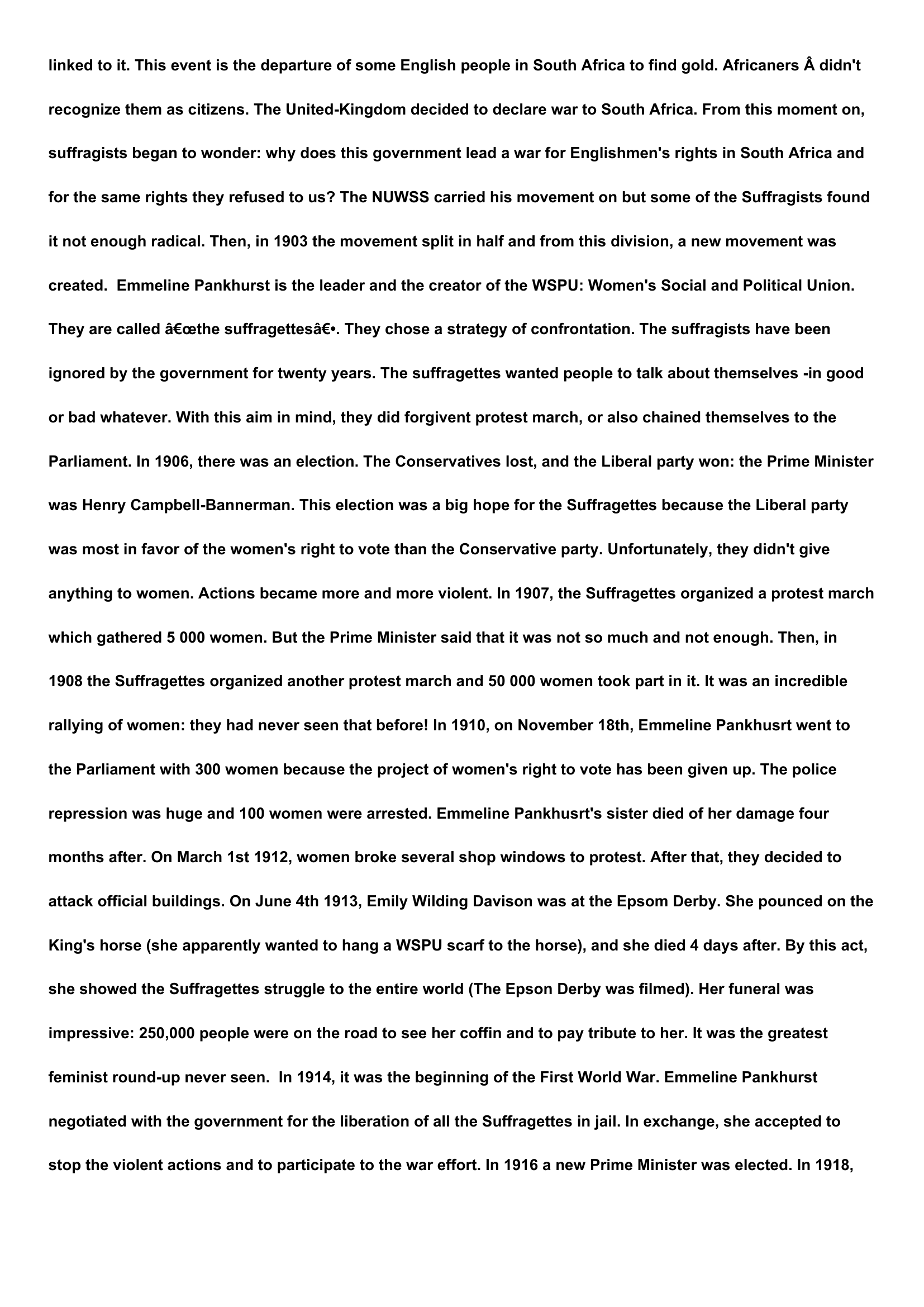droit de vote des femmes en angleterre
Publié le 24/04/2016
Extrait du document


«
linked to it.
This event is the departure of some English people in South Africa to find gold.
Africaners didn't
recognize them as citizens.
The United-Kingdom decided to declare war to South Africa.
From this moment on,
suffragists began to wonder: why does this government lead a war for Englishmen's rights in South Africa and
for the same rights they refused to us? The NUWSS carried his movement on but some of the Suffragists found
it not enough radical.
Then, in 1903 the movement split in half and from this division, a new movement was
created.
Emmeline Pankhurst is the leader and the creator of the WSPU: Women's Social and Political Union.
They are called “the suffragettes”.
They chose a strategy of confrontation.
The suffragists have been
ignored by the government for twenty years.
The suffragettes wanted people to talk about themselves -in good
or bad whatever.
With this aim in mind, they did forgivent protest march, or also chained themselves to the
Parliament.
In 1906, there was an election.
The Conservatives lost, and the Liberal party won: the Prime Minister
was Henry Campbell-Bannerman.
This election was a big hope for the Suffragettes because the Liberal party
was most in favor of the women's right to vote than the Conservative party.
Unfortunately, they didn't give
anything to women.
Actions became more and more violent.
In 1907, the Suffragettes organized a protest march
which gathered 5 000 women.
But the Prime Minister said that it was not so much and not enough.
Then, in
1908 the Suffragettes organized another protest march and 50 000 women took part in it.
It was an incredible
rallying of women: they had never seen that before! In 1910, on November 18th, Emmeline Pankhusrt went to
the Parliament with 300 women because the project of women's right to vote has been given up.
The police
repression was huge and 100 women were arrested.
Emmeline Pankhusrt's sister died of her damage four
months after.
On March 1st 1912, women broke several shop windows to protest.
After that, they decided to
attack official buildings.
On June 4th 1913, Emily Wilding Davison was at the Epsom Derby.
She pounced on the
King's horse (she apparently wanted to hang a WSPU scarf to the horse), and she died 4 days after.
By this act,
she showed the Suffragettes struggle to the entire world (The Epson Derby was filmed).
Her funeral was
impressive: 250,000 people were on the road to see her coffin and to pay tribute to her.
It was the greatest
feminist round-up never seen.
In 1914, it was the beginning of the First World War.
Emmeline Pankhurst
negotiated with the government for the liberation of all the Suffragettes in jail.
In exchange, she accepted to
stop the violent actions and to participate to the war effort.
In 1916 a new Prime Minister was elected.
In 1918,.
»
↓↓↓ APERÇU DU DOCUMENT ↓↓↓
Liens utiles
- Droit de vote des femmes en France - INTRODUCTION pour un dossier documentaire
- Le droit de vote des femmes au 19e siècle : Introduction
- droit de vote des femmes
- Le droit de vote des femmes
- Les femmes luttent pour leurs droits : l'accès à une formation supérieure, au travail et au droit de vote avance peu à peu

































